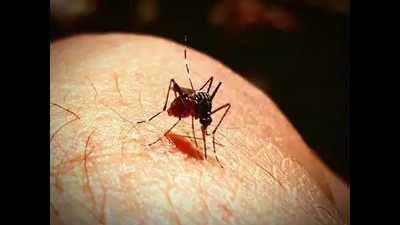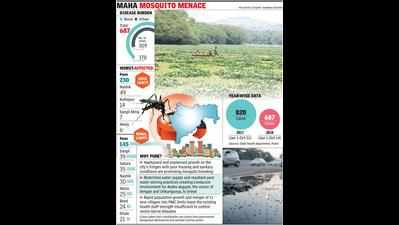Trending
This story is from November 13, 2018
At 375 cases, chikungunya hits Pune hardest in state
Ineffective surveillance and poor planning have ensured that Pune retains its dubious distinction of recording maximum chikungunya cases in the state in 2018 as well, third year in a row.
PUNE: Ineffective surveillance and poor planning have ensured that Pune retains its dubious distinction of recording maximum chikungunya cases in the state in 2018 as well, third year in a row.
As per the latest report of the state health department, the state recorded 687 chikungunya cases between January and October 14 this year. Of these, Pune (city and rural areas) accounted for maximum 375 cases, which come to around 54% when compared with the state’s disease burden.(see box)

When contacted, Pune Municipal Corporation (PMC) officials blamed the drizzle and showers witnessed in September, October and even in November for the prevailing situation. “These showers resulted in water accumulation, creating conducive breeding grounds for Aedes aegypti — the mosquito that causes dengue and chikungunya. Besides the extended rainfall, wide fluctuation in day and night temperatures is also one of the reasons for the city reporting maximum cases,” Sanjeev Wavare, head of the insect control department, PMC, told TOI.
“The civic health staffers are not carrying out weekly surveillance and anti-larval work effectively. Entomological surveillance is the gold standard to prevent spread of mosquito-borne diseases, which is often neglected or done half-heartedly,” activist Sanjay Dabhade said.
Rural areas worst-hit
Chikungunya cases, just like that of dengue, are also on the rise in the state’s rural parts, the report revealed.
“This year, we have recorded more cases of chikungunya in the state’s rural parts than their urban counterparts. As many as 378 cases were recorded in the state’s rural parts as against 309 from the municipal corporation areas. Water scarcity and unplanned growth and sanitation issues are at the root of these cases,” state entomologist Mahendra Jagtap said.
As per the state’s records, there were 348 chikungunya cases in the rural parts and 2,601 in the civic areas in Maharashtra in 2016. Similarly, there were 411 cases in the state’s rural parts and 1,027 cases in the civic limits in 2017.
Medical practitioners said man-made surroundings play a big role in cases where vector is the mosquito. “Eco-climatic conditions and man-made surroundings often have a big role to play in such cases,” senior paediatrician Sharad Agarkhedkar said.
Besides, chikungunya cases are often underreported. “Since chikungunya is usually clinically diagnosed by doctors based on a patient’s symptoms, a patient is often prescribed symptomatic treatment without being subjected to further diagnostic tests,” he said.
As per the latest report of the state health department, the state recorded 687 chikungunya cases between January and October 14 this year. Of these, Pune (city and rural areas) accounted for maximum 375 cases, which come to around 54% when compared with the state’s disease burden.(see box)

When contacted, Pune Municipal Corporation (PMC) officials blamed the drizzle and showers witnessed in September, October and even in November for the prevailing situation. “These showers resulted in water accumulation, creating conducive breeding grounds for Aedes aegypti — the mosquito that causes dengue and chikungunya. Besides the extended rainfall, wide fluctuation in day and night temperatures is also one of the reasons for the city reporting maximum cases,” Sanjeev Wavare, head of the insect control department, PMC, told TOI.
These claims, however, failed to find any favour with health activists who blamed the civic body’s ineffective surveillance and anti-larval works for the rise in the number of cases.
“The civic health staffers are not carrying out weekly surveillance and anti-larval work effectively. Entomological surveillance is the gold standard to prevent spread of mosquito-borne diseases, which is often neglected or done half-heartedly,” activist Sanjay Dabhade said.
Rural areas worst-hit
Chikungunya cases, just like that of dengue, are also on the rise in the state’s rural parts, the report revealed.
“This year, we have recorded more cases of chikungunya in the state’s rural parts than their urban counterparts. As many as 378 cases were recorded in the state’s rural parts as against 309 from the municipal corporation areas. Water scarcity and unplanned growth and sanitation issues are at the root of these cases,” state entomologist Mahendra Jagtap said.
As per the state’s records, there were 348 chikungunya cases in the rural parts and 2,601 in the civic areas in Maharashtra in 2016. Similarly, there were 411 cases in the state’s rural parts and 1,027 cases in the civic limits in 2017.
Medical practitioners said man-made surroundings play a big role in cases where vector is the mosquito. “Eco-climatic conditions and man-made surroundings often have a big role to play in such cases,” senior paediatrician Sharad Agarkhedkar said.
Besides, chikungunya cases are often underreported. “Since chikungunya is usually clinically diagnosed by doctors based on a patient’s symptoms, a patient is often prescribed symptomatic treatment without being subjected to further diagnostic tests,” he said.
End of Article
FOLLOW US ON SOCIAL MEDIA












